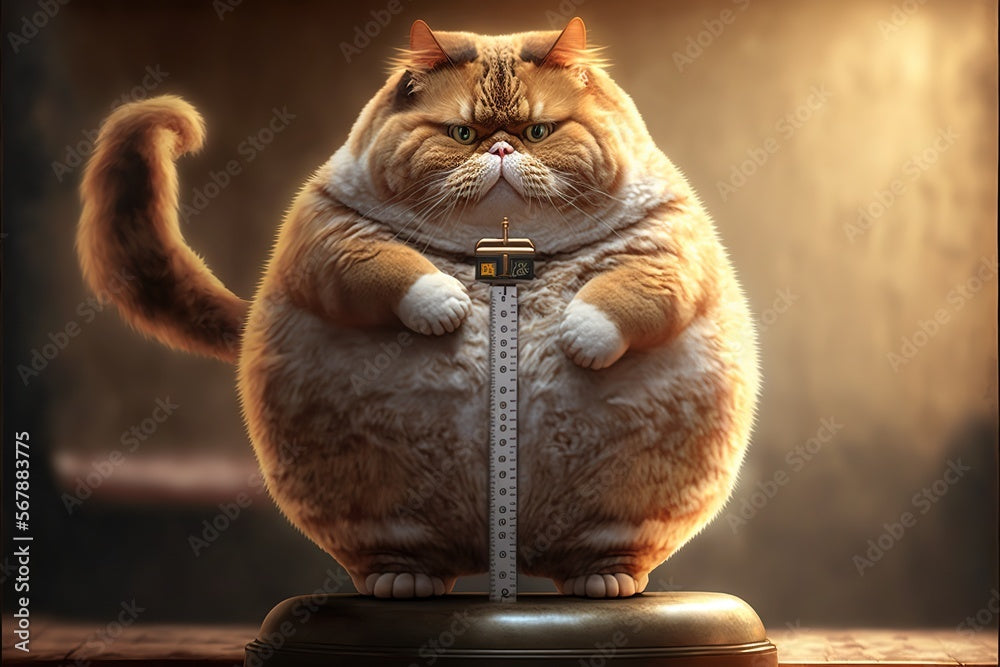Are you worried about your overweight feline friend? If so, you are not alone! Fat cats are becoming increasingly common, and with the rising trend comes a plethora of health issues that can affect your beloved pet. It’s crucial for every cat owner to understand essential care tips for fat cats to ensure they remain healthy and happy. This is an urgent call to action that will guide you on how to take control of your fat cat's well-being and provide them with the quality life they deserve.

Understanding the Risks of Obesity in Cats
Before we dive into the fat cats tips cares, it’s vital to understand the implications of feline obesity. Just like in humans, excess weight in cats can lead to severe health problems, including diabetes, arthritis, and heart disease. Studies show that overweight cats have a significantly lower life expectancy than their slimmer counterparts. This isn't merely about aesthetics; it’s about longevity and quality of life. If you love your cat, it's time to take action!
In addition to the physical health risks, obesity can also affect your cat's mental health and behavior. Overweight cats may experience depression, anxiety, and even reduced social interactions. A lack of exercise can make them lethargic and less interested in playtime, which can further exacerbate their weight problem. It's a vicious cycle that requires immediate attention. Understanding the full scope of obesity's impact can serve as the motivation you need to make changes in your cat's life.
Recognizing the Signs of Obesity
How do you know if your cat is overweight? There are several indicators that can help you identify whether your feline friend has crossed the line from fluffy to fat:
- Visible Fat Deposits: Look for fat pads around the abdomen, hips, and ribs. If you can’t feel their ribs without excess pressure, it’s time for a change.
- Difficulty Grooming: If your cat struggles to groom themselves due to their weight, this is an unmistakable sign that they need to shed some pounds.
- Decreased Activity Levels: Has your cat become a couch potato? Any noticeable decline in activity can indicate weight issues.
- Breathing Problems: Heavy panting or labored breathing is a red flag that your cat is overweight.
- Joint Pain: Pay attention to your cat's mobility. Difficulty jumping, climbing, or playing can signal the need for weight management.
Consult Your Veterinarian
It cannot be stressed enough how important it is to consult with your veterinarian. This step should not be overlooked if you are serious about your cat’s health. A veterinarian can offer a comprehensive health assessment, rule out underlying conditions, and help you develop a tailored weight loss plan. This proactive approach is crucial in ensuring any dietary or lifestyle changes you make are safe and effective.
During your visit, be candid about your concerns regarding your cat's weight. Ask questions and seek guidance on the best food options, exercise routines, and general care tips. Your vet knows your cat's medical history and can provide you with the most reliable advice. Additionally, they may even have resources like weight management programs or workshops that can offer more in-depth guidance.
Revamping Your Cat’s Diet
Food plays a foundational role in managing your fat cat’s weight. Here are some essential care tips on what to feed your feline:
1. Choose High-Quality Cat Food
Select a high-quality, nutritionally balanced cat food that is specifically formulated for weight management. Read the labels carefully and avoid foods that are high in fillers like corn and wheat. Look for options with high protein content and low carbohydrates to keep your cat feeling full without added calories. High-quality food ensures that your cat gets the right nutrients without unnecessary additives.
2. Controlled Portion Sizes
Portion control is crucial in any weight management plan. Use a measuring cup to serve your cat's food rather than free-feeding throughout the day. Follow the feeding guidelines provided by your veterinarian and the cat food manufacturer. Consider dividing their daily intake into smaller, more frequent meals to keep their metabolism active. This method can help manage hunger levels and prevent your cat from begging for more food.
3. Manage Treat Intake
It’s tempting to spoil your fat cat with treats, but moderation is key. Opt for low-calorie treats and incorporate healthy snacks like small pieces of cooked chicken or fish. Always account for treat calories in your cat’s daily intake. Remember, even healthy treats can add up quickly, so always keep track of what and how much you’re giving your cat.
4. Consider Wet Food vs. Dry Food
Many experts suggest incorporating wet food into your cat’s diet, especially for those on a weight loss journey. Wet food generally contains fewer carbohydrates and more water, which can help in maintaining hydration and satiety. Speak with your veterinarian about finding the right balance between wet and dry food for your fat cat.
Encouraging Physical Activity
Diet alone isn’t sufficient; you also need to encourage your fat cat to exercise. Here are some fun and effective ways to get them moving:
1. Interactive Toys
Invest in interactive toys that stimulate your cat's natural hunting instincts. Feather wands, laser pointers, and treat-dispensing toys can engage your cat mentally and physically. These toys can be a great way to ensure that your cat is not only active but also mentally stimulated, reducing boredom and improving their overall mood.
2. Create an Obstacle Course
Set up a mini obstacle course in your home using cushions, boxes, and tunnels. Encourage your cat to navigate the course using treats as motivation. This fun activity can burn calories and keep your cat entertained. Not only does this improve their physical fitness, but it also strengthens the bond between you and your kitty as you play together.
3. Daily Playtime
Establish a routine for daily playtime. Spend at least 15 to 20 minutes engaging with your cat each day. Even just tossing a ball or crumpled paper can get them moving and help shed those extra pounds. Consistency is key here; make playtime a regular part of your cat's routine to help keep them active and healthy.
4. Leash Training for Outdoor Adventures
If your cat is amenable, consider leash training your feline for safe outdoor exploration. Cats can enjoy an outdoor walk just as much as their canine counterparts. This allows them to experience new sights, smells, and sounds while burning calories, providing tremendous mental stimulation.
Creating a Safe and Stimulating Environment
A stimulating environment is essential for a happy and healthy cat. Here are some tips for creating such an atmosphere:
1. Cat Trees and Scratching Posts
Providing cat trees and scratching posts not only offers a place to play and climb but also promotes exercise. Cats love to scratch and climb, and these structures can provide an outlet for that behavior while keeping them active. Ensure that the scratching posts are tall and sturdy enough to encourage regular use.
2. Safe Outdoor Access
If feasible, allow your cat to explore your yard or a safe outdoor space. Supervised outdoor time can stimulate their senses and encourage natural behaviors. If a fully enclosed yard isn’t an option, consider a catio to provide a secure outdoor environment for your cat to enjoy.
3. Rotate Toys Regularly
Keep your cat's interest alive by regularly rotating their toys. Cats can get bored with the same toys, and changing them up can reignite their enthusiasm for play. You don’t need to purchase new toys; simply swapping out old ones can create excitement and stimulation.
4. Provide Vertical Space
Many cats enjoy climbing. Consider adding shelves or window perches where your cat can observe their surroundings and engage in acrobatic leaps. Providing vertical space encourages exercise and satisfies their natural instincts to explore and survey their territory.
Monitoring Progress and Adjustments
Once you’ve implemented a new diet and exercise regimen, tracking your cat’s progress is essential. Regular weigh-ins are recommended; aim for a monthly check with your veterinarian to monitor their weight loss journey. Be patient, as healthy weight loss takes time, typically around 1% to 2% of body weight per week.
In addition to weigh-ins, keep an eye on your cat’s overall condition. Are they more active? Are they grooming themselves better? These are positive signs of progress that should be celebrated along the way. Keeping a journal can help you track changes in behavior, activity levels, and even your cat’s mood.
Signs of Improvement
As your cat loses weight, you may notice several positive changes:
- Increased Energy Levels: An active fat cat is a happy cat. As they shed pounds, you’ll likely see an uptick in their energy.
- Improved Grooming: With excess weight gone, your cat will be able to groom themselves more effectively.
- Better Mobility: Reduced weight can lead to improved mobility, making it easier for your cat to play and explore.
- Better Temperament: Weight loss can significantly improve a cat’s mood, as they can engage in activities they once struggled with.
- Enhanced Relationships: As your cat becomes more active, you may notice an improvement in their social interactions, both with you and other pets.
Preventing Future Weight Gain
Once your fat cat reaches their ideal weight, it’s essential to take preventive measures to keep them from regaining. Here are some tips on maintaining your cat's healthy weight:
1. Continue with Regular Veterinary Check-Ups
Regular check-ups allow your vet to monitor your cat's health and weight maintenance. They can provide guidance on adjusting diet and exercise as your cat’s needs change. Regular professional monitoring ensures you stay on the right track and make any necessary adjustments.
2. Establish a Routine
Consistency is key in preventing future weight gain. Stick to a regular feeding and exercise schedule to help your cat maintain a healthy weight. Cats thrive on routine; establishing this will become second nature for both of you. Consistency not only helps with weight management but also contributes to your cat’s overall sense of security.
3. Be Mindful of Seasonal Changes
Seasonal changes can affect activity levels. In winter, cats may be less active due to cold weather. Ensure you find ways to engage your cat indoors during these months, such as new toys or activities that mimic outdoor play. Keeping them stimulated and active during these times is vital for maintaining their healthy weight.
4. Socialization with Other Pets
If you have other pets, encourage social interaction that leads to play. Cats often enjoy playing with other kittens or even engaging with dogs in safe settings. Social play can be beneficial for mental and physical activity, leading to a healthier lifestyle fundamentally.
Final Thoughts
As a responsible pet owner, you have the power to keep your fat cat healthy and happy. Implementing the essential care tips for fat cats is not just a matter of aesthetics; it’s a commitment to their health and longevity. Regular veterinary visits, a balanced diet, controlled portions, and ample opportunities for exercise are crucial to your cat's well-being. Don’t let your beloved pet fall into the traps of obesity. Take action today and show your fat cat that you care!
Every small step counts in their journey to a healthier life, and you aren't just helping them lose weight; you're enhancing their happiness, too. Remember, a fat cat is a serious matter – make the change for a better, brighter future for your furry friend. With your dedication and the right resources, you can transform your fat cat into a healthier, happier companion. Together, you and your cat can embark on this rewarding journey!






Share:
Tips for Keeping Your Pets Safe and Happy During the Christmas Holidays
Energize Your Lazy Dog